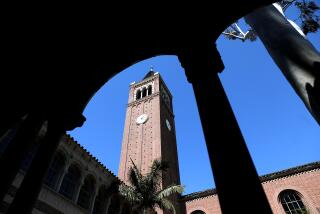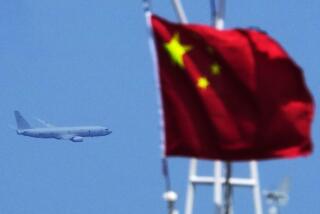In China, blame for the USC victims
- Share via
After USC graduate students Ming Qu and Ying Wu were shot and killed earlier this month, the Chinese student community in America was saddened, shocked and frightened.
The reaction back home was very different. The killings, which happened while Qu and Wu were sitting and talking in a BMW, unleashed a torrent of Internet vitriol in China, and it wasn’t directed at the pair’s attacker.
A comment on the popular site 163.com was typical: “Studying in America, driving BMW, a male and a female, let them die.”
Never mind that the BMW was a secondhand model and not the $60,000 luxury model the Associated Press erroneously reported initially. Or that Qu and Wu were not especially rich or well connected: Qu’s father is a manager at an insurance company, his mother a teacher. Wu’s father is a police investigator and her mother a retired textile worker.
Another commenter on 163.com posted this: “We should think about why a lot of families, even the poor ones, spend a lot to send their children abroad. This is meaningless. Studying abroad only contributes to American GDP…. Stop cheating us.”
The malevolence this tragedy generated grows out of deep divisions within China. The chasm between haves and have-nots is growing ever wider, and with it has come resentment that extends to the approximately 160,000 students a year — enough to populate three schools the size of UCLA — who elect to study in the United States.
Disdain for American-educated students has come only recently. During China’s economic expansion in the 1980s, students educated abroad were feted and valued for the skills and knowledge they acquired, which were then scarce in China. The students were dubbed hai gui, or “sea turtles,” as opposed to “land tortoises,” the term for those who stayed home to get their education.
Now, thanks to a vast expansion of the higher education system, China is awash in domestically educated college graduates. And increasingly, employers in China see graduates returning from the United States as problematic hires with unrealistic salary expectations. They don’t even come back with the same kind of English skills they used to because there are now so many Chinese students on U.S. campuses that they can socialize almost exclusively among themselves.
The result has been a new term to describe returning students who can’t find work — hai dai, or “seaweed.”
Having come from abroad to study in the United States myself (as a Malaysian citizen), I have great sympathy for the difficulty foreign students face trying to chase their dreams in an alien country.
Most Chinese graduate students come to the United States straight from college, with little or no work experience. They have usually been far more sheltered than American students of the same age. Most of those who make it to the United States to study have spent their childhoods cramming, always pointed toward the nationwide gao kao university entrance exam, a test so important that construction work is stopped, traffic diverted and parents take work leave to coddle or bully their kids through the ordeal. (Some parents have even been known to put their daughters on birth control pills so they won’t be distracted with menstrual cramps during the test.)
Even the most media-savvy Chinese students have a touching naivete about what it means to study in America. A few years ago, one of the sharpest and smartest researchers at the Beijing Wall Street Journal bureau won a full scholarship to Columbia. I warned her to expect bad cellphone reception and rats and urine on the subway. She was incredulous, disbelieving. To her, America meant lattes and luxury cars.
Most Chinese students I’ve worked with as a lecturer in USC’s Annenberg School or interviewed as a reporter have hoped to work in the United States for a few years after graduation. Many no longer succeed in that goal. The U.S. job market is brutal, and attitudes and stereotyping compound the problem.
In this clash of cultures, it is helpful to remember America’s historical openness to China scholars, and the dividends it has paid. More than a century ago, the Boxer Rebellion led to the U.S. government sponsoring the first group of Chinese scholars to attend U.S. colleges. This first wave returned home to build China’s railroads and steamships, won at least one Nobel Prize and helped to build Tsinghua University, China’s equivalent of MIT. The first wave of sea turtles following China’s economic opening in the 1980s — people such as Charles Zhang, founder of Sohu, and Robin Li, founder of Baidu — built China’s Internet and helped open up the nation’s information pathways.
So what about this generation, this seaweed tide?
Unlike the earlier generations of China scholars, they are not just majoring in the hard sciences. They are in creative writing programs, in art schools, even in journalism, despite media restrictions back home.
This is no small thing. Even as many Americans make the mistake of viewing China as a monolithic superpower, the Chinese, too, tend toward one-sided views of America. America the imperialist oppressor; America the violent. It’s a view that Qu’s and Wu’s tragedy unfortunately reinforces.
But there is also another dimension to the Chinese view of America. It is a country many admire as a place of hope and possibilities and opportunity, the land that created Steve Jobs and Jeremy Lin. This is the America that draws ever-growing numbers of Chinese students, who then take home a view of the United States that refutes the stereotypes.
Such an exercise of informal diplomacy on a grand scale cannot help but change U.S.-China relations. It may even change the world.
Mei Fong, formerly a China correspondent for the Wall Street Journal, is now a lecturer at USC’s Annenberg School for Communication and Journalism.
More to Read
A cure for the common opinion
Get thought-provoking perspectives with our weekly newsletter.
You may occasionally receive promotional content from the Los Angeles Times.










